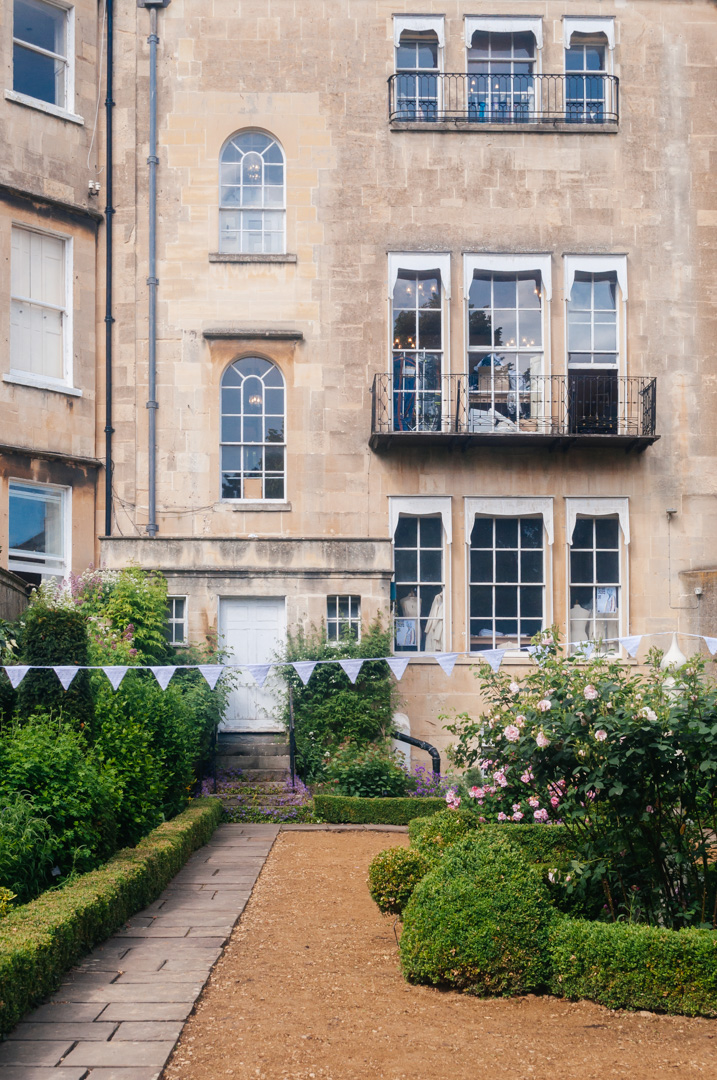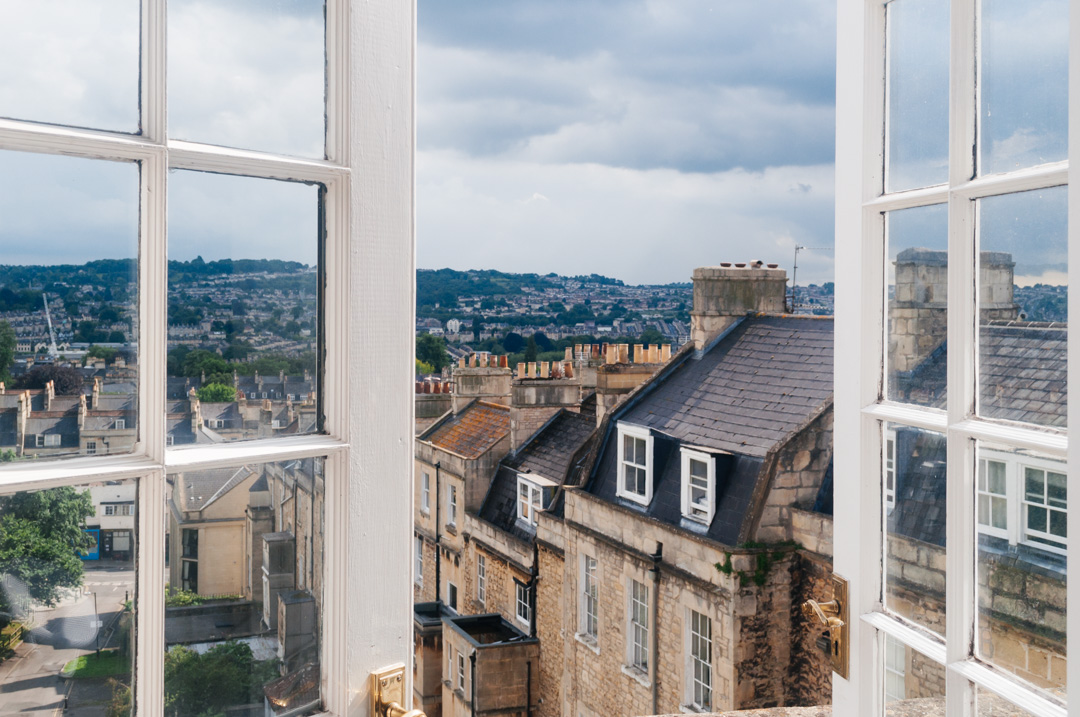There’s something fascinating about the warm hue of Bath stone. Those majestic period buildings that seem to glow under the Sun. With clean-cut blocks and fine details. But there’s a catch.
Bath stone, like a good limestone, is prone to dirt and decay. In fact, my house looked like a sandcastle under heavy rain. What do you do when it’s time to clean and restore it?
Little mistakes can cost you thousands. I’ve written this Bath stone cleaning and repair guide to highlight all the pitfalls and conservation crimes I’ve committed. A must-read before you call the stonemason.
Let’s talk about Bath stone

Where does it come from?
The area that is now Bath was a warm shallow sea in the Jurassic Period. I like to imagine it like the Caribbean version of Somerset with dinosaurs prancing. Anyway, the little sand grains in the seabed were slowly coated in lime and sediments.
Fast forward 150 million years, and you have limestone. And my favourite fact about it? Sometimes you can find bits of shells and skeletons of marine creatures in it. Exactly what you need for your window sill.
What colour is it?
The colour of this stone is instantly recognisable. A lovely light golden sand hue that delighted the Romans. This honey colour contrasts with the popular white-grey Portland limestone.
You may have heard of Dorset’s Portland stone. It’s everywhere — from St Paul’s Cathedral to the British Museum. But, what about Bath stone? Well, it has remained a local building material for centuries. Used in some parts of the south of England, and to a lesser extent in south Wales.
Where is it used?
The finest example is Bath, with its UNESCO World Heritage status. Most period and modern buildings in the city are made of local limestone. There’s a certain beauty in this urban homogeneity.
The influence of this material also reached the exotic land of Wales. The front of my Victorian terraced house in Cardiff is made of Bath and blue pennant stone. At first, I thought I had been blessed with such beautiful materials. But, after the surveyor had a look, it all became clear. It’s a curse.
Even though only my window and door surrounds are made of Bath stone, it has cost me thousands to clean and restore a few blocks. Let’s have a look and discover the ins and outs of limestone cleaning and repair — with no despair.
Bath stone cleaning

Dirty stonework is a common sight in urban areas. The main cause is pollution from car exhausts, which accumulates over time. Limestone is less durable than sandstone as it’s prone to decay with pollution and acid rain. That’s why you won’t see many Bath stone buildings in London.
There is an important question you should ask yourself before you start. Why do you want to clean Bath stone? Is it to enhance the appearance or remove paint? Do you want to blend old stone with new materials? Are you going to prepare it for new pointing or repair?
These are the three main cleaning methods
If you love your house avoid dry air abrasion, high-pressure water sprays and acids. The stone specialist will advise you on the best procedure. Below, you will find some of the recommended techniques. Download the full Council guidance (PDF).
- Physical: Good old brushing and rubbing, and wet air abrasion.
- Water-based: Intermittent sprays with minimal use of water.
- Chemical: Poulticing, a water-free gel that solidifies and eliminates dirt when removed.
Cleaning is not always the solution
If the building is slightly soiled, there’s no need to do anything. However, heavily soiled stone decays quick. This is due to a series of chemical reactions I don’t understand. The ivy on the wall has to go. It looks pretty, but it’s a stonemason’s worst nightmare.
Moss or lichens are not a problem. In fact, conservation bodies recommend that lichens should be preserved as they’re an essential part of the stone’s patina. They’re the stickers of nature.
Stages of Bath stone repair and restoration

Every house is unique. The process is complex for listed buildings. In that case, you will need planning permission to clean or restore Bath stone. Always check with your local authority as a survey may be needed. These are the different stages from least to most invasive:
1. No treatment
Light surface erosion and weathering is not a problem. It’s part of an old building’s character.
2. Keep water away from stone
If you have a bay window, install guttering to keep the water away from the sills. Make sure that the leading is in tip-top condition too. A small amount of lime mortar can avoid water traps and help the rain flow away from the stone.
3. Cosmetic repairs
Small repairs to damaged stone can be done with tinted lime mortar. Never use cement as it won’t allow the water to evaporate. Treat significant surface erosion with a mixture of lime mortar and stone dust (Bath stone mix). If done properly, you won’t notice the difference. In some cases, it’s also possible to fit a new stone face. But the material may age differently than the old one.
4. Replace stone blocks
This is the absolute last resort as it’s an invasive and expensive procedure. The damaged blocks are replaced with new ones of matching colour. Sounds simple, but don’t be fooled. It’s a major job.
The five Bath stone cleaning and repair mistakes to avoid

Doing work on this limestone will cost you thousands. Don’t risk it — I’ve been there. That’s why I’m sharing these costly mistakes with you. Some of these I’ve made myself, others were caused by the previous owners.
1. Not getting the right tradesman for the job
Always use a specialist firm that only works with Bath stone. No exceptions. I don’t care if your cousin Pete is good at DIY. Bye, Pete! You need someone with precision skills and extensive stone knowledge. Check their qualifications, website and independent reviews.
Get at least five quotes. And never go for the cheapest one (they’re desperate). Make sure your chosen company or professional doesn’t subcontract or delegate part of the job to untrained people. They brought a guy who works in a pasty shop to do jobs in my house…
2. Using harsh chemicals
Most of the time gentle cleaning methods are enough to get the job done. And if the building is listed, the local Council won’t let you use anything that could damage or alter its character. The previous owners of my house cleaned the stone with buckets of acid. It must have been on offer.
As a result, the stone decayed ten times faster than normal. Peeling away day after day. There was sand all over the place every time it rained. It looked like some kind of ruin from the lost city of Atlantis.
3. Painting over Bath stone
Don’t do it — ever. There is no situation where painting this limestone will be beneficial. It has to breathe so any water particles that filter through can escape. Removing the paint will be costly. And you may damage the stone in the process (see point 2).
4. Doing it in the wrong order
Remember the dust storms from the film Interstellar? For your own sanity, don’t decorate your home before restoring the outside. Get ready for six months of ultra-fine dust filtering through the house. You can try with the vacuum cleaner and the broom. It won’t go away. You must wipe all surfaces regularly.
The stone in my house was so eroded that it led to a penetrating damp problem inside. Now that the leaks are gone, I have to re-plaster part of the room. It will cause a mess — again. It’s best if you tackle the exterior first and then focus on decorating the interior.
5. Cleaning it in the winter
Most popular cleaning methods use water. Because of this, there is a high risk of frost damage to the stone in the winter months. This makes summer the ideal season. The porous stone can dry faster and there are no severe temperature changes. What did I do? Clean it in December!
Help! I need someone to repair my Bath stone
Are you looking for a professional to restore or replace your Bath stone? Recommendations are gold! Your best bet is to look around your area. Check the houses that have been cleaned to a good standard and ask the owners if they’re able to recommend any stonemasons or companies.
A Google search can also help you identify potential candidates. Note I’m unable to give you recommendations or specific advice. I can only help if you’re looking for interior advisory and well-being coaching services.
Have you been blessed with a period home with limestone?

What do you do to maintain it? This is an introduction to the care of this material. But let me know if you think I missed anything. And don’t forget to check my 7 golden rules of Victorian house renovation (most apply to period homes in general).




Caroline
•8 years agoGreat tips – I wish I was lucky enough to live in a bath stone house! I love Bath too, such a beautiful city – I used to live in Bristol, so I would visit often and I really miss it.
Juan Sandiego
•8 years agoThank you for your comment, Caroline! Bath stone is not the most exciting of topics ? Ah, Bristol. Yes, it’s so close to Bath. Next time you’re near Bristol you have to visit Cardiff!
Adam Hickman
•8 years agoHello
Any tips on how to remove soot from Bath stone? I’m putting in a new log burner and there’s lovely bath stone for the opening but there’s a bit of soot and General cleaning that needs doing to the stone. Any tips appreciated. Thanks!
Juan Sandiego
•8 years agoThank you for your comment, Adam! I must say I have no idea, but I’ve found this article that can help you.
Matt Gamble
•7 years agoHi – Im thinking of sanding my internal (used to be an outside wall 30 years ago before an extension was built) Bath stone wall with a sanding disc.
Do you know if this is possible please?
Thanks,
Matt
Juan Sandiego
•7 years agoThank you for your comment, Matt! It may be possible but note Bath stone is extremely soft and it’s easy to sand more than it’s needed. Hope it works for you!
Mrs Carrie Lees
•7 years agoAdvice please! My parents ashes are in interred in St Nicholas Church Bathampton, Avon. The small inscribed Bath stone marking the plot has become covered in lichen. I would like to clean it – p
please advise. Thank you. Carrie.
Juan Sandiego
•7 years agoThank you for your comment, Carrie! Lichen is not considered an issue with Bath stone, it’s part of its patina. Generally speaking, it’s best left there. If in doubt, contact a local stonemason. Hope this helps.
Steve Maggs
•7 years agoHello,
Is there any way to prevent the algae build up in the first place? I live in a renovated building with a curved roof. It was completely black when I arrived and the builders have cleaned it all off. However, every 6 months the algae grows back. I just wonder if it could be treated to avoid the build up?
Thanks
Juan Sandiego
•7 years agoThank you very much for your comment, Steve! If algae keep coming back is because there is a significant amount of moisture or water. There could be a faulty gutter. I know there are some chemical products designed to prevent algae in patios, but you’d have to check the instructions to see if it’s suitable for Bath stone. Hope it helps!
Sue
•7 years agoCan you recommend a company to clean the original stone floor in our Georgian home? It has old ? Lead paint stains and ? Bitumen from stuck down Lino . Would like to restore this floor.thanks
Juan Sandiego
•7 years agoThank you for your comment, Sue! Perhaps a Google search including your location may help. Bath stone is not used for flooring so the blog post above may not apply to you.
Stephanie
•7 years agoHello,
I have had stone masons on my property for three months (when they could fit me in between jobs) due to a weather delay etc. The company informed me after start date that my stone was particularly bad and that whoever had worked on it previously (the neighbours say it’s had four attempts) were absolute cowboys and have lost all of the detail etc. I’m really not happy, it looks the same as when they started. I don’t know whether I need to consider new stone. A second opinion would be great but they Mason’s in Cardiff seem to all know each other or work together!
Juan Sandiego
•7 years agoThank you for your comment, Stephanie! You’re right, all the traders know each other. My stone was badly damaged too and there’s a point where sometimes they even have to replace parts of it with new stone. As nice as it is, Bath stone is not a future-proof material due to the weather in the UK. Hopefully, if they’re considerate they’ll achieve a good result. My stone doesn’t look perfect but it’s better than before.